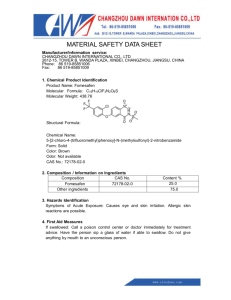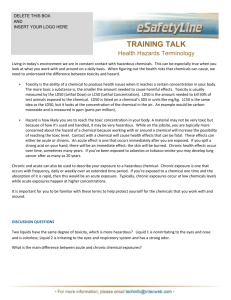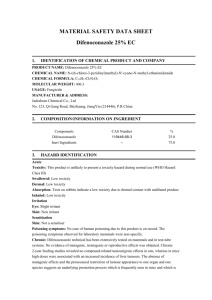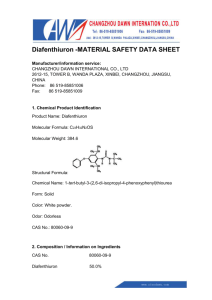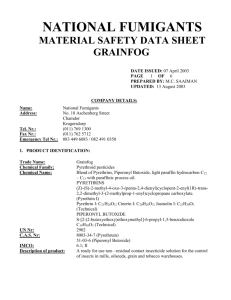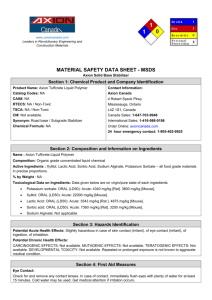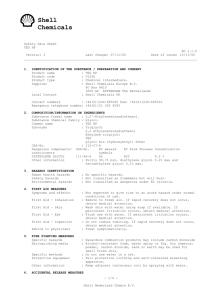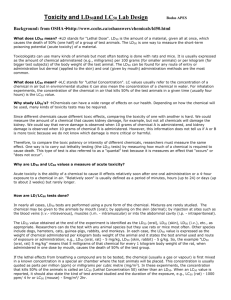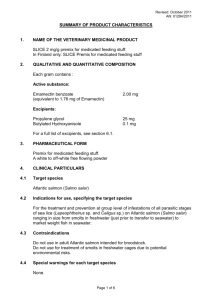DOWN LOAD
advertisement
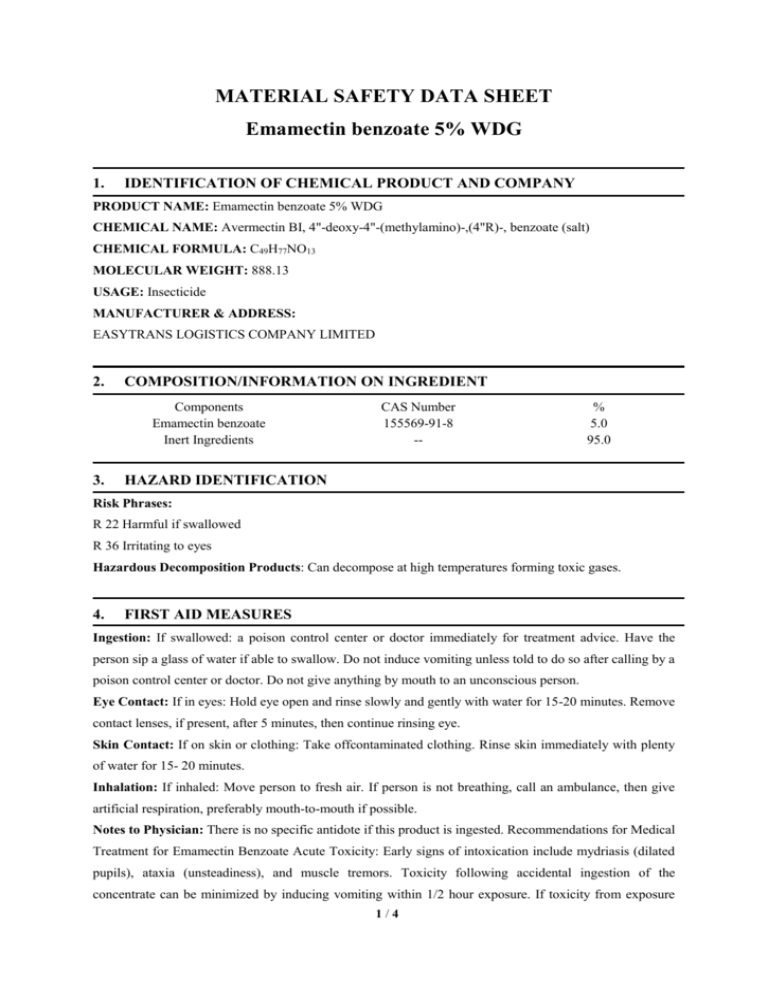
MATERIAL SAFETY DATA SHEET Emamectin benzoate 5% WDG 1. IDENTIFICATION OF CHEMICAL PRODUCT AND COMPANY PRODUCT NAME: Emamectin benzoate 5% WDG CHEMICAL NAME: Avermectin BI, 4"-deoxy-4"-(methylamino)-,(4"R)-, benzoate (salt) CHEMICAL FORMULA: C49H77NO13 MOLECULAR WEIGHT: 888.13 USAGE: Insecticide MANUFACTURER & ADDRESS: EASYTRANS LOGISTICS COMPANY LIMITED 2. COMPOSITION/INFORMATION ON INGREDIENT Components Emamectin benzoate Inert Ingredients 3. CAS Number 155569-91-8 -- % 5.0 95.0 HAZARD IDENTIFICATION Risk Phrases: R 22 Harmful if swallowed R 36 Irritating to eyes Hazardous Decomposition Products: Can decompose at high temperatures forming toxic gases. 4. FIRST AID MEASURES Ingestion: If swallowed: a poison control center or doctor immediately for treatment advice. Have the person sip a glass of water if able to swallow. Do not induce vomiting unless told to do so after calling by a poison control center or doctor. Do not give anything by mouth to an unconscious person. Eye Contact: If in eyes: Hold eye open and rinse slowly and gently with water for 15-20 minutes. Remove contact lenses, if present, after 5 minutes, then continue rinsing eye. Skin Contact: If on skin or clothing: Take offcontaminated clothing. Rinse skin immediately with plenty of water for 15- 20 minutes. Inhalation: If inhaled: Move person to fresh air. If person is not breathing, call an ambulance, then give artificial respiration, preferably mouth-to-mouth if possible. Notes to Physician: There is no specific antidote if this product is ingested. Recommendations for Medical Treatment for Emamectin Benzoate Acute Toxicity: Early signs of intoxication include mydriasis (dilated pupils), ataxia (unsteadiness), and muscle tremors. Toxicity following accidental ingestion of the concentrate can be minimized by inducing vomiting within 1/2 hour exposure. If toxicity from exposure 1/4 has progressed to cause severe vomiting, the extent of resultant fluid and electrolyte imbalance should be gauged. Appropriate supportive parenteral fluid replacement therapy should be given, along with other required supportive measures (such as maintenance of blood pressure levels) as indicated by clinical signs, symptoms, and measurements. In severe cases, observations should continue for at least several days until clinical condition is stable and normal. Since emamectin benzoate is believed to enhance GABA activity in animals, it is wise to avoid drugs that enhance GABA activity (barbiturates, benzodiazepines, valproic acid) in patients with a potentially toxic exposure. Medical Condition Likely to be Aggravated by Exposure: Individuals with pre-existing eye lesions or nervous system dysfunctions should avoid contact with this material. 5. FIRE FIGHTING MEASURES Unusual Fire, Explosion and Reactivity Hazards During a fire, irritating and possibly toxic gases may be generated by thermal decomposition or combustion. In Case of Fire: Use dry chemical, foam or C02 extinguishing media. Wear full protective clothing and self-contained breathing apparatus. Evacuate nonessential personnel from the area to prevent human exposure to fire, smoke, fumes or products of combustion. Prevent use of contaminated buildings, area, and equipment until decontaminated. Water runoff can cause environmental damage. If water is used to fight fire, dike and collect runoff. 6. ACCIDENTAL RELEASE MEASURES In Case of Spill or Leak Control the spill at its source. Contain the spill to prevent it from spreading, contaminating soil, or entering sewage and drainage systems or any body of water. Clean up spills immediately, observing precautions outlined in Section 8. If a solid, sweep up material and place in a compatible disposal container. Pick up wash liquid with additional absorbent and place into compatible disposal container. Once all material is cleaned up and placed in a disposal container, seal container and arrange for disposition. 7. HANDLING AND STORAGE Store the material in a well-ventilated, secure area out of reach of children and domestic animals. Do not store food, beverages or tobacco products in the storage area. Prevent eating, drinking, tobacco use, and cosmetic application in areas where there is a potential for exposure to the material. Wash thoroughly with soap and water after handling. 8. EXPOSURE CONTROLS/PERSONAL PROTECTION The following recommendations for exposure controls/personal protection are intended for the manufacture, formulation, packaging and use of this product. For commercial applications and/or on-farm applications consult the product label. 2/4 Ingestion: Prevent eating, drinking, tobacco usage and cosmetic application in areas where there is a potential for exposure to the material. Wash thoroughly with soap and water after handling. Eye Contact: Where eye contact is likely, use chemical splash goggles. Facilities storing or utilizing this material should be equipped with an eyewash facility and a safety shower. Skin Contact: Where contact is likely, wear chemical-resistant (such as nitrile or butyl) gloves, coveralls, socks and chemical-resistant footwear. For overhead exposure, wear chemical-resistant headgear. Inhalation: A combination particulate/ organic vapor respirator may be necessary until effective engineering controls are installed to comply with occupational exposure limits. Use a NIOSH approved respirator with an organic vapor (OV) cartridge or canister with an HE prefilter. Use a self-contained breathing apparatus in cases of emergency spills, when exposure levels are unknown, or under any circumstances where air-purifying respirators may not provide adequate protection. 9. PHYSICAL AND CHEMICAL PROPERTIES Appearance: Off-white granule Melting Point: Not Available Boiling Point: Not Applicable PH: 6.0-8.0 Suspensibility: ≥80.0 10. STABILITY AND REACTIVITY Stability: Stable under normal use and storage conditions. Hazardous Polymerization: Will not occur. Conditions to Avoid: Heat and light. Materials to Avoid: None known. Hazardous Decomposition Products: Can decompose at high temperatures forming toxic gases. 11. TOXICOLOGICAL INFORMATION Acute Toxicity - Oral LD50: 1510 mg/kg Acute Toxicity - Dermal LD50: >200 mg/kg Acute Toxicity -Inhalation LC50 (rat) (4hr) > 6.2 mg/l Eye Irritation Mild eye irritant. Skin Irritation Mild skin irritant. Sensitisation: Shouldn’t cause sensitisation by skin contact. 12. ECOLOGICAL INFORMATION Birds: Acute oral LD50 for mallard ducks 46, bobwhite quail 264 mg/kg. Dietary LC50 (8 d) for mallard ducks 570, bobwhite quail 1318 ppm. 3/4 Fish: LC50 (96 h) for rainbow trout 174, sheepshead minnow 1430 µg/l. Daphnia: LC50 0.99 µg/l. Bees: LD50 (24h) oral 0.0036 µg/bee 13. DISPOSAL CONSIDERATIONS Disposal: Do not reuse product containers. Dispose of product containers, waste containers, and residues according to local, state, and federal health and environmental regulations. Characteristic Waste: Not Applicable Listed Waste: Not Applicable 14. TRANSPORT INFORMATION UN Number: 3077 Hazard class: 9 Packing group: Ⅲ 15. REGULATORY INFORMATION No data 16. OTHER INFORMATION STATEMENT NOTICE The information and recommendations contained herein is believed to be reliable and are presented in good faith by the supplier. The information is supplied upon the condition that users and handlers of the product will make their own determination as to its suitability for their purpose prior to use. In no event will the supplier be responsible for damages of any nature concerning the handling and use of this product. Handlers and users of the product assume all risks and liabilities arising from its handling, use or application. 4/4
